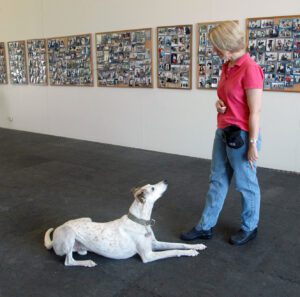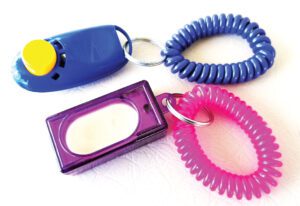A dog training clicker is a small low-tech device that makes a distinct and consistent clicking noise. There isn’t any magic to it; on its own, it doesn’t compel a dog to do anything. However, if you consistently follow its use with a food treat (or other salient reward), the dog will quickly learn that the noise predicts something good is coming his way – and what’s more, that he can make the noise (and treat) happen again by repeating whatever he was doing at the moment he heard the click.
When used in this way, the clicker is an example of a reward marker – which can be any consistent signal that allows you to precisely mark the moment your dog does a desired behavior and promises that a reward is coming soon. The advantage of a clicker over a verbal reward marker (such as saying a word like “Yes!”) is that the clicker makes the exact same sound each time you press it. Humans naturally sound more enthusiastic at some times than others, which can inadvertently introduce some concern or confusion for the dog, but the clicker always sounds the same!
Types of Clickers
There are many different kinds of clickers, but most are made with a small piece of metal inside of a plastic box; you press one end of the metal to make it flex, which makes the clicking sound. Some have a button that presses the metal strip instead. Some are just held in the palm of your hand; others have a retractable cord in a holder that you can clip to your waistband or treat pouch; still others have a coiled bracelet that you can wear on your wrist, so you can drop the clicker and still have it handy.
How to Use a Clicker

- Start by “charging” the clicker. This means teaching your dog that the “click” means a treat is forthcoming. To avoid scaring your dog, start with the clicker in your pocket. “Click,” pause a second or two, and feed your dog a tasty treat. (Be sure to pause briefly; if you move the treat too soon the click becomes irrelevant.) Repeat several times: Click, pause, treat. If the sound doesn’t bother him, put the clicker behind your back for a few more repetitions of click, pause, treat. By now he’s probably perking up when he hears the click because he knows a treat is coming!
Hold the clicker at your waist and click, pause, and treat a few more times. (Note: Keep the clicker still, do not move it toward the dog when you click – it’s not a TV remote!)
- Begin marking behaviors that you want to reinforce. Ask your dog to perform a behavior that he knows, such as sit. When he sits, click, pause, and give him a treat. You’re telling him he got the treat for sitting.
If he doesn’t know how to do any behaviors on cue yet, lure him into a desired behavior position, such as sit. Lure him into the sit, click the moment his bottom touches the ground, and give him a treat. Lure him into the sit another couple of times, giving him a click and then a treat each time his bottom touches the ground; then wait a few seconds to see if he will offer a sit without the lure. If he does, click and give him a treat! You should soon see that your dog will do new behaviors that you mark with the clicker more quickly, more easily, and more often. Now you can use the clicker for anything you want to teach your dog!
Is Your Dog Afraid of the Click?
Some dogs are highly sound-sensitive and look concerned or plainly scared at the sound of a clicker. If this is the case, instead using a clicker, you can either use a verbal marker (I tell my clients to just say “click”) or make a clicking sound with your mouth. Some people can make a consistent sort of popping sound by snapping their tongue off the roof of their mouth; others use a sort of clucking sound in their cheek like you’d use to ask a horse to move forward.






